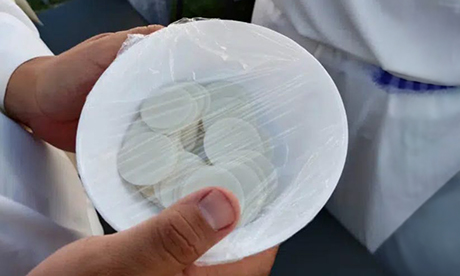A wave of controversy has engulfed the World Youth Day (WYD) event held in Lisbon last week, as concerns were raised about the handling of the Eucharist during the lead-up to the papal mass on Sunday.
The controversy erupted after images circulated on social media depicting plastic containers placed on tables inside a white tent, with young individuals kneeling in front of them.
These containers were reported to house the Blessed Sacrament, prompting outrage and discussions about whether this was an appropriate manner to handle such a revered element of Catholic faith.
This follows from an instance earlier in the week when photographs of ciboria full of consecrated hosts and covered in cellophane began to circulate online.
According to some, these were “Ikea potato chip bowls” that had been purchased at the last minute to distribute Communion.
However, the Ikea ciboria were used during a Mass organised by the very large Spanish contingent — not in a Mass organised by World Youth Day itself.
Fr Nuno Coelho, a pastor in Cascais, who was a World Youth Day liaison to the Spanish pilgrims, told The Pillar that the group brought their own ciboria to Portugal.
“From what we gathered, these are the ciboria that the Spanish [bishops’ conference] youth apostolate generally use for large outdoor Masses. They look a little like breakfast bowls,” he said.
“The official WYD ciboria were designed by artisans, they are made of silver plate and they have a sliding articulated lid, to protect the consecrated hosts from the wind during distribution. The Spanish ones had no covering, but there was a very strong wind in the park, so they had them covered in plastic film to protect the hosts.”
Protection from dust and wind
The second controversy surrounded the overnight storage of the Blessed Sacrament in plastic containers.
One participant, who wished to remain anonymous, shed light on the situation. According to the volunteer, consecrated hosts were initially placed in metal ciboriums, which were then encased in plastic containers.
These measures were undertaken to facilitate safe transportation and protect the Eucharist from outdoor elements like wind and dust. The crates, situated within various tents across the campsite, were intended solely for safeguarding purposes, not for adoration.
The situation escalated when curiosity among attendees led to inquiries about the plastic boxes’ contents. Upon learning of the presence of the Eucharist, pilgrims began to engage in adoration. This likely marked the moment when photographs capturing young individuals kneeling before the containers went viral.
The controversy has led to debates about the organisation and communication surrounding the event.
While smaller tents housing the ciboria were scattered throughout Campo da Graça, their contents remained largely unknown without inside information or direct investigation. The official WYD app listed the papal vigil as the sole scheduled Eucharistic adoration session.
Sources
Additional readingNews category: Great reads, World.




